Recession Ending, Celebrate Economic Growth in Third Quarter
Economics / Recession 2008 - 2010 Aug 16, 2009 - 03:47 PM GMTBy: Paul_L_Kasriel
 We had been expecting that real economic growth would emerge in the fourth quarter of this year, coinciding with the celebrations of the Thanksgiving and Christmas holidays. We now think that it might emerge, albeit, just barely, in the third quarter, in time for the Labor Day celebration - although labor will have little to celebrate. We arrive at this conclusion from observing some economic variables that typically signal the end of a recession. And these economic variables are subject to little, if any, revisions.
We had been expecting that real economic growth would emerge in the fourth quarter of this year, coinciding with the celebrations of the Thanksgiving and Christmas holidays. We now think that it might emerge, albeit, just barely, in the third quarter, in time for the Labor Day celebration - although labor will have little to celebrate. We arrive at this conclusion from observing some economic variables that typically signal the end of a recession. And these economic variables are subject to little, if any, revisions.
These variables are elements of the ISM Manufacturing Survey, the Challenger lay-off survey and initial unemployment claims. The only revisions to the ISM manufacturing survey data are annual updates to the seasonal-adjustment factors. The unadjusted data are never revised. The Challenger lay-off survey data are never revised. The initial unemployment claims data do get revised, but after four weeks, what you see is what you get for time immemorial. So, let's look at the historical behavior and recent behavior of these variables.
First off is the Production Index in the monthly ISM Manufacturing Survey. Chart 1 shows that the Production Index typically traces out a v-shaped response at or near the end of a recessionary period (shaded area in chart). Also, the Production Index has rebounded to the 50 level around the end of recessions. The Production Index stood at levels of 52.5 and 57.9 in June 2009 and July 2009, respectively.
Chart 1
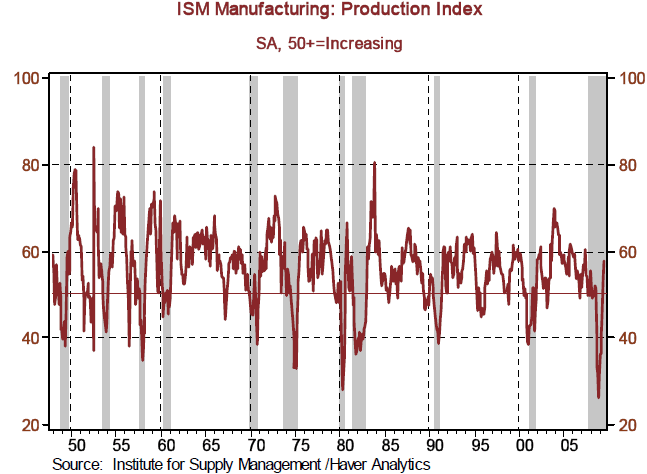
Similar cyclical behavior is exhibited by the ISM Manufacturing Survey New Orders Index as shown in Chart 2. The level of the New Orders Index stood at 55.3 in July. These indices have drawbacks. They are more directional-type measures rather than quantitative. That is, these indexes measure whether production or new orders are increasing or decreasing but not by how much they are increasing or decreasing. But we repeat: the underlying data never are revised and the behavior of these data comport well with the ending of recessions. And oh yes, for you conspiracy theorists out there, it would strain credulity to think that federal government agents are putting pressure on Norbert Ore, the chairman of the ISM Manufacturing Business Survey Committee, to falsify survey results.
Chart 2
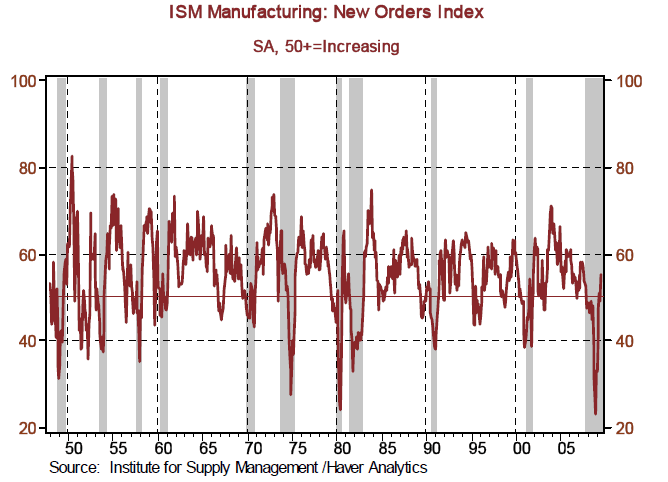
Each month Challenger, Gray & Christmas, an employment consulting firm, total up the number of corporate layoffs that have been announced for that month. These lay-off totals are not seasonally adjusted. So, it is best to look at them on a year-over-year percent-change basis, as we have done in Chart 3. The published data provided by Challenger start only in March 1989. So, the data span only three recessionary periods, including the current one. The limited history of the data suggests that when the year-over-year percent change in the number of announced employee lay-offs falls to zero, or thereabouts, the recession is over. In June and July 2009, the year-over-year percent changes were minus 9.00 and minus 5.75, respectively. Based on an admittedly limited history, these readings suggest that the recession is over. Again, only an extreme conspiracy theorist would believe that federal government agents pressured corporate executives to lie about their planned lay-offs.
Chart 3

Every week, the Department of Labor reports the number of people lining up across the fifty states in America to file for unemployment insurance for the first time - i.e., for the first time in their current bout of unemployment. The weekly number you see flashing below CNBC's Rick Santelli on Thursday morning is seasonally adjusted. We believe that seasonally adjusting data is an art; we believe that seasonally adjusting weekly data is abstract art. So we prefer to examine year-over-year changes in unadjusted data. But even those data are "noisy." So to try to smooth out more noise, we take a 4-week moving average of the unadjusted data and then calculate the year-over-year percent change in the moving average. As shown in Chart 4, the year-over-year percent increase in the 4-week average tends to peak near the end of recessions, similar to what the data are now showing. As mentioned earlier, these data do get revised, but relatively little compared to other federal government economic statistics.
Not everyone who has recently become unemployed qualifies to receive unemployment insurance benefits. For example, a new entrant to the labor force would not qualify. To qualify at a minimum, one has to have been employed just prior to one's current bout of unemployment. So, in this sense, the weekly initial unemployment claims are not a statistical universe of the newly unemployed. But the bean counters at the Department of Labor do not try to statistically "blow up" the raw data to estimate a universe. The weekly data represent real people standing in real lines (or real online lines) filing first-time unemployment insurance claims. Now, if government agents wanted to falsify data, we suppose these data could be falsified. But it is interesting how the behavior of the current initial jobless claims data is consistent with the current ISM Manufacturing and Challenger lay-off data - data much more unlikely to have been "fudged." In sum, these data plus our economic-forecasting version of the Magic Eight Ball are saying that all signs point to an economic recovery.
Chart 4

We did not expect the change in real personal consumption expenditures to break into positive territory until the fourth quarter of this year. But the "cash-for-clunkers" program may have moved up this event. New car and truck sales accelerated at an annualized pace of 11.2 million units in July from 9.7 million in June. Given that the cash-for-clunkers program only became operative near the end of July, it would appear that some of the relative strength in July car and truck sales had more fundamental underpinnings. Funding for the cash-for-clunkers program has been increased by $2 billion from its original $1 billion amount. So, it will have a positive impact on motor vehicle sales in August and possibly September. But we have to be careful in evaluating this program's boost to consumer spending in isolation. For starters, households might increase their purchases of motor vehicles but cut back on other current spending (which may have been reflected in the 0.5% decline in July nominal retail sales excluding motor vehicles and gasoline). Moreover, the program is probably just bringing forward some motor vehicle sales that might have taken place later in the year. So, there likely will be some payback in terms of slower sales in the fourth quarter, similar to what happened after the surges in motor vehicle sales in October 2001 and July 2005 in connection with some juicy incentives (see Chart 5).
Chart 5

While real consumer expenditures are expected to boost real GDP in the third quarter, exports are likely to be less of a drag. Appealing again to nongovernmental survey data, the New Export Orders Index in the ISM Manufacturing Survey moved marginally above the 50 level (50.5, to be exact) in July (see Chart 6). Whether this improving export situation for the U.S. is related to the rebound in the pace of economic activity in some important Asian developing economies (see Chart 7), in the words of one of our grandmothers, may she rest in peace, "It couldn't hurt." Chart 8 shows that nominal unadjusted U.S. exports of goods were up about $48.5 billion in the second quarter, $35.8 billion of which were to Pacific Rim economies.
Chart 6

Chart 7

Chart 8
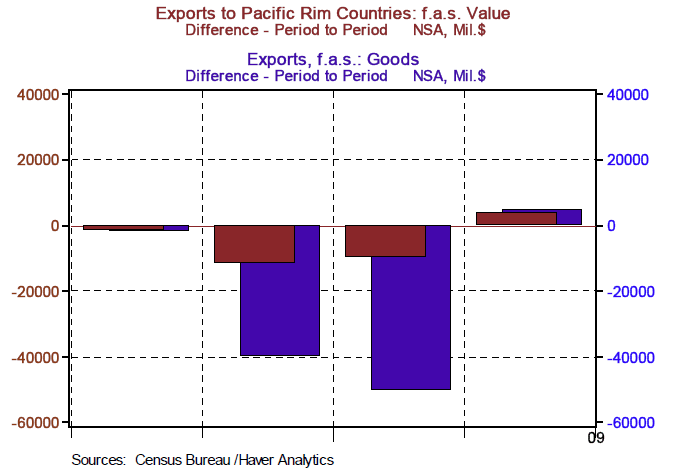
With regard to the nearly $800 billion fiscal stimulus program, there is a lot of chatter that (a) it is and will be a failure in lifting measured economic activity or (b) a second stimulus program will be needed. Our response is that it is too early to say for either "a" or "b." According to ProPublica, an independent, non-profit newsroom that produces investigative journalism and who has recently employed a friend of ours and a good investigative journalist, Jesse Eisinger, only about $57 billion or 10% of the spending portion of the stimulus program (as opposed to the tax cut portion) has actually been dispersed ("Just 12 Percent of Stimulus Money Has Been Spent", ProPublica.org). (If we read ProPublica correctly, the numbers we quoted are exclusive of the $250 bonuses paid to each Social Security recipient, which totaled $13 billion.) But our bet is that federal government agencies will be stepping up their efforts to cut more checks. Although haste makes waste, it all counts in the GDP accounts.
Perhaps related to the fiscal stimulus program, we find it interesting that in the second quarter nominal expenditures (can't trust the real or deflated data, right?) by state & local governments increased by 1.4% and 10% for general services (consumption) and infrastructure (infrastructure), respectively (see Chart 9). These increases come on the heels of two consecutive quarters of contractions in both categories of state & local government spending. With these governments in such strained fiscal positions, how could they manage to boost spending in the second quarter? Part of the federal stimulus program was a rebate to state & local governments that issued taxable bonds to fund infrastructure projects. These bonds are called "Build America Bonds" (BABs). BABs undoubtedly played a role in boosting second-quarter infrastructure spending by state & local governments. The small increase in general services expenditures in the second quarter likely would have otherwise have been the third consecutive quarterly contraction had it not been for direct federal aid from the stimulus program to state & local governments.
Chart 9
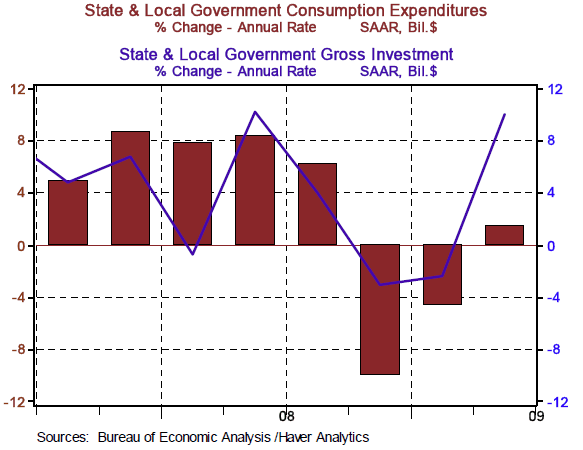
Lastly, what has been a developing story for the past several months, the residential real estate market is improving. Both new and existing home sales increased in each of the three months ended June. Although still elevated, inventory-to-sales ratios for new and existing homes are falling, which typically is the prelude to increased housing starts. And, in fact, starts for single-family homes have increased in each of the four months ended June. This suggests that housing component of real GDP, real residential investment expenditures, will be less of a drag in the third quarter and will have stopped contracting by the fourth quarter of this year.
Although we believe the recovery has commenced, we do not believe that the "wind" is at the back of the recovery yet. While the financial markets are thawing, credit is not free-flowing. For example, consumer credit contracted at an annualized rate of 4.3% in the past two quarters - the sharpest two-quarter rate of contraction in the post-WWII era (see Chart 10).
Chart 10

Household leverage at the end of the first quarter was at a record high 21.9% vs. 18.2% at the end of the first quarter of 2003 (see Chart 11). Although households have a lot of work to do to get their balance sheets repaired, keep in mind that in the past year the factor driving up leverage has been the sharp decline in the market value of household assets (see Chart 12). Household liabilities actually fell in three of the past four quarters ended the first quarter of this year (see Chart 13). With the rise in the U.S. stock market since March and the slowdown in the rate of decline in house prices, combined with the paydown in household debt, household leverage is likely to begin moving lower soon.
Chart 11
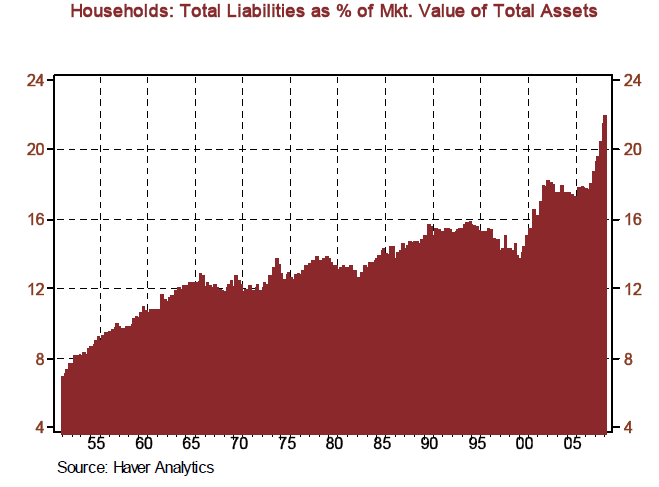
Chart 12

Chart 13

The financial sector faces renewed headwinds from losses associated with commercial real estate mortgages. Although significant, these losses would not be expected to be as large as was experienced with residential mortgages. Why? As Chart 14 shows, the dollar amount outstanding of residential mortgages far exceeds that of commercial mortgages. At the end of 2007, the amount of residential mortgages outstanding was $11.9 trillion compared to $2.6 trillion for commercial mortgages.
Chart 14
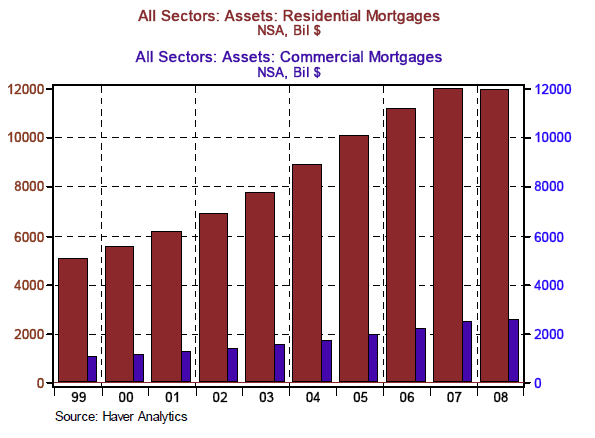
There is concern being voiced that after the fiscal stimulus wears off, the economy will lapse back into a recession. Anything is possible, but that does not necessarily make it highly probable. In the post-WII era, once the U.S. economy has gained forward motion, it has maintained that forward motion until the Federal Reserve has intervened to halt it (see Chart 15). We believe that the earliest the Fed will begin to take action to brake the pace of nominal economic activity will be late-June of 2010. And if it begins to take action then, it will do so only tentatively. If, in fact, economic activity is flagging from a lack of additional fiscal stimulus, then the Fed is unlikely to commence tightening or would reverse course. We believe that the next recession, whenever it occurs, will be precipitated by the lagged effects of Fed tightening, not by the economy "running out of gas" on its own.
Chart 15

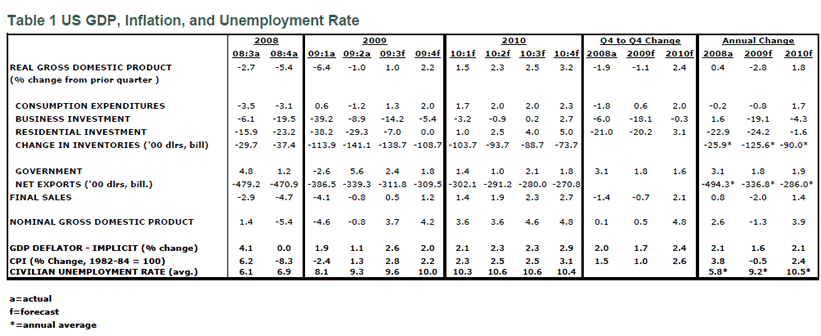
Paul Kasriel is the recipient of the 2006 Lawrence R. Klein Award for Blue Chip Forecasting Accuracy
By Paul L. Kasriel
The Northern Trust Company
Economic Research Department - Daily Global Commentary
Copyright © 2009 Paul Kasriel
Paul joined the economic research unit of The Northern Trust Company in 1986 as Vice President and Economist, being named Senior Vice President and Director of Economic Research in 2000. His economic and interest rate forecasts are used both internally and by clients. The accuracy of the Economic Research Department's forecasts has consistently been highly-ranked in the Blue Chip survey of about 50 forecasters over the years. To that point, Paul received the prestigious 2006 Lawrence R. Klein Award for having the most accurate economic forecast among the Blue Chip survey participants for the years 2002 through 2005.
The opinions expressed herein are those of the author and do not necessarily represent the views of The Northern Trust Company. The Northern Trust Company does not warrant the accuracy or completeness of information contained herein, such information is subject to change and is not intended to influence your investment decisions.
Paul L. Kasriel Archive |
© 2005-2022 http://www.MarketOracle.co.uk - The Market Oracle is a FREE Daily Financial Markets Analysis & Forecasting online publication.



